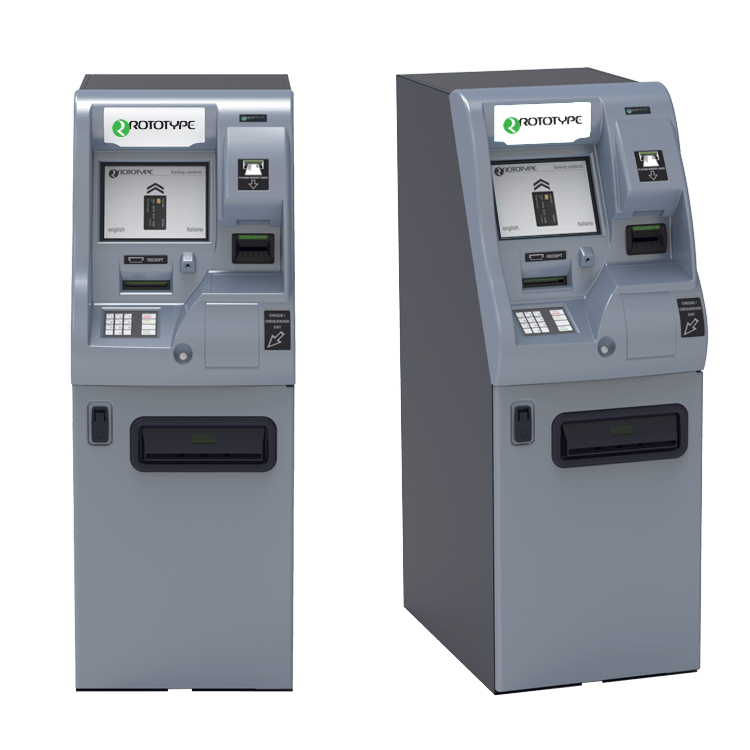SELF SERVICE KIOSK FOR CHEQUEBOOK DISPENSER
Banks and Financial Institutions are continuously seeking to keep satisfying their customers with more effective and complete services in terms of quality, efficiency and availability, while at the same time focusing on personnel cost reduction and training, and on converting most of their employees from cash activity towards more profitable activities, such as the promotion of financial services and investments.
During the last few years in fact, great efforts have been directed towards the automation of all the banking functions so as to give customers services available 24/7.
In this scenario, the cheque-dispensing function has had a limited diffusion, mainly because of the equipment manufacturers’ difficulty to assemble cheque-sized paper printed by laser printers in booklet format.
Rototype CJD 8000 now perfectly fills this gap by enabling banks to automate even the cheque-dispensing function, ensuring the fast issuing of high quality fully customizable branch/user booklets characterized by inkjet printing quality.
Customers can access the kiosk identifying themselves with their card, choose between several predefined booklet layouts such as “corporate”, “personal”, or others, choose the number of cheques, and subsequently obtain, in a couple of minutes, a superior quality chequebook made up of customized cheques with their personal details and logo.
In addition to chequebooks, and thanks to its excellent graphical capabilities allowing to enter/record the cashier's signature, CJD 8000 can also deliver, upon the customer's request, single “cashier orders” or “gift cheques” of the entered amount.
Connectivity, a high reliability and a wide range of powerful and user-friendly software tools geared towards booklet design, machine tuning, maintenance and troubleshooting, add the finishing touches to CJD 8000, making it a truly omni-comprehensive cheque printing solution, unique in the market.
Main features
The CJD 8000 kiosk is designed in compliance with regulations reducing discrimination against people with disabilities and it typically includes a 12” LCD with touch screen, a motorized EMV-approved Card Reader, a VISA PCI Encrypting Pin pad, a transaction thermal printer and a backlit panel suitable to be customized with an institution's logo.
The internal cheque printing module is fed by means of two 1500-sheet cassettes able to accommodate/house various paper sizes: one is intended for blank cheques while the other feeds blank covers, order forms and other relevant forms (i.e. advertising or other) assembled in a pre-assigned sequence.
Cheques are first encoded by means of a thermal transfer MICR ribbon, followed by a MICR verifier which can validate the encoding process enabling the subsequent step which is the customized printing through high resolution inkjet capable of performing a 300dpi resolution printing in all the cheque areas.
Cheques and covers are then collected in the booklet assembling area, capable of collecting up to 50 cheques plus covers, where they are aligned at first, then stapled and bound by means of an adhesive tape.
A final step is represented by the dispensing station, which includes a specially provided box for storing retracted chequebooks that the customer failed to withdraw.
The design concept is similar to a pipeline built with the various stations, which means that at the same time several cheques are on fly moving long edge first, each one under a different module function, so as to maximize performances and produce, for example, a 25 sheet booklet in less than 100 seconds.
Inside the cabinet, there is a specially provided space for the main computer, with Microsoft Windows OS operating system, which interfaces with the printing module through an Ethernet link and with the outside world in such a way as requested by the deploying Organization.
There is also an embedded Web server which enables to operate quickly to perform maintenance operations on some basic machine functions by means of an Internet browser, therefore without installing any kind of driver and software.
Software
Several tools, most of them supplied complimentary/free of charge, have been developed to assist the booklet-design process, the installation tests, service procedures such as fine tuning parameters, diagnostic and troubleshooting, massive tests, demonstration and also the framework for a real cheque printing solution for ATM-style machines.
Please click for more details.
RotoDraw
RotoDraw is an intuitive and user-friendly tool suitable for the chequebook design process. The application developer should define a certain number of templates, one for each sheet type as cheque, front cover, order form, back cover, advertising and so on, and for each of them it will be possible to allocate printing fields in a WYSIWYG mode throughout all the sheet area choosing from an unlimited set of graphic resources as fonts and bitmaps.
BitFont
BitFont is a graphic resource editor generator. In order to speed up the printing process, CJD8000 printers need resident permanently stored resources. BitFont can inherit character fonts and bitmaps from Windows systems, graphically edit and convert them into the CJD format, ready to be used once transferred to the machine.
CJD Service tool
Service tool is a professional tool designed for maintenance and service operators which allows to test each single device of the machine, such as motors and solenoid valves, to program some activation sequences, or to test complete subsystems, such as aligners, printers, binding station and so on. It also allows to fine-tune/perfect all the machine parameters in a really simple and intuitive way. Service tool can be used for upgrading the machine firmware and graphical resources as well as for downloading diagnostic traces in case of the occurrence of particular events that need to be submitted to Rototype technicians.



